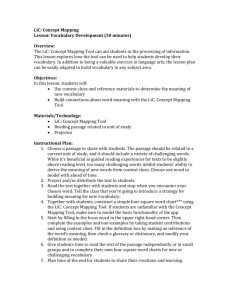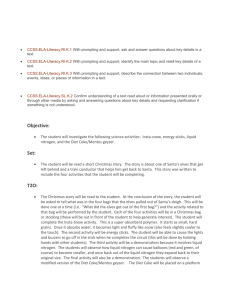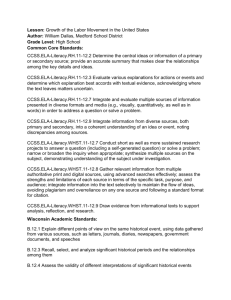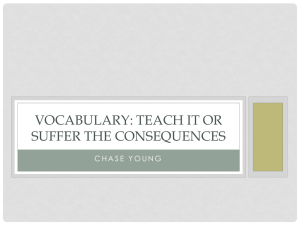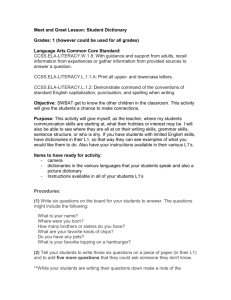Lesson for September 18, 1999: Cultural Focus
advertisement
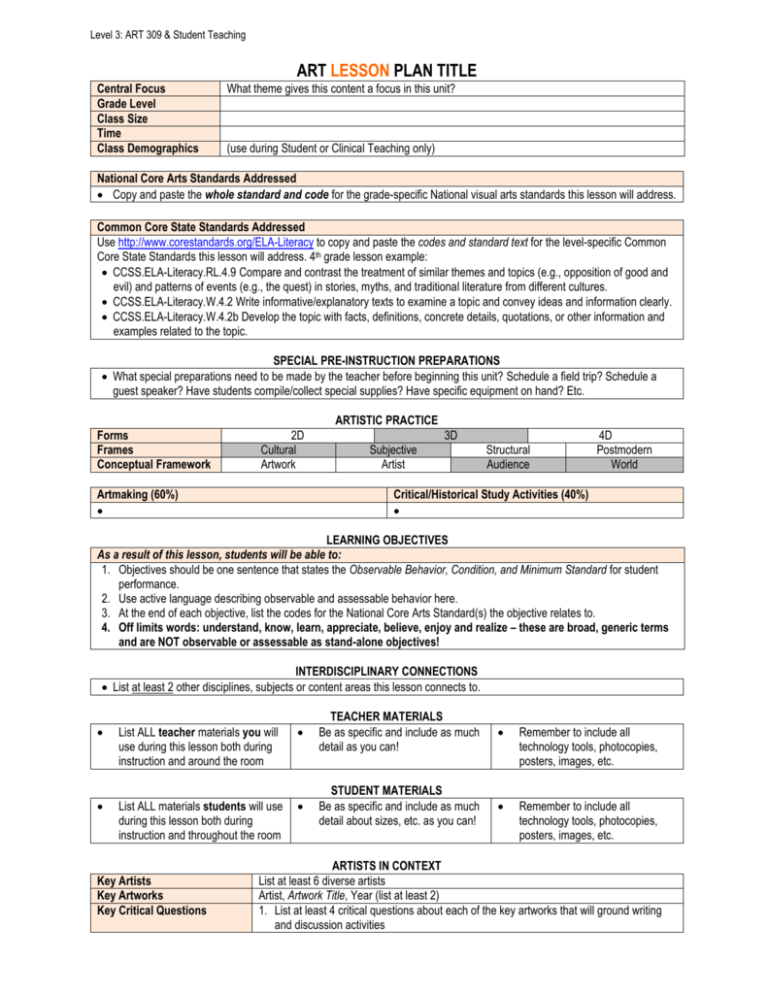
Level 3: ART 309 & Student Teaching ART LESSON PLAN TITLE Central Focus Grade Level Class Size Time Class Demographics What theme gives this content a focus in this unit? (use during Student or Clinical Teaching only) National Core Arts Standards Addressed Copy and paste the whole standard and code for the grade-specific National visual arts standards this lesson will address. Common Core State Standards Addressed Use http://www.corestandards.org/ELA-Literacy to copy and paste the codes and standard text for the level-specific Common Core State Standards this lesson will address. 4th grade lesson example: CCSS.ELA-Literacy.RL.4.9 Compare and contrast the treatment of similar themes and topics (e.g., opposition of good and evil) and patterns of events (e.g., the quest) in stories, myths, and traditional literature from different cultures. CCSS.ELA-Literacy.W.4.2 Write informative/explanatory texts to examine a topic and convey ideas and information clearly. CCSS.ELA-Literacy.W.4.2b Develop the topic with facts, definitions, concrete details, quotations, or other information and examples related to the topic. SPECIAL PRE-INSTRUCTION PREPARATIONS What special preparations need to be made by the teacher before beginning this unit? Schedule a field trip? Schedule a guest speaker? Have students compile/collect special supplies? Have specific equipment on hand? Etc. ARTISTIC PRACTICE Forms Frames Conceptual Framework 2D Cultural Artwork Artmaking (60%) 3D Subjective Artist Structural Audience 4D Postmodern World Critical/Historical Study Activities (40%) LEARNING OBJECTIVES As a result of this lesson, students will be able to: 1. Objectives should be one sentence that states the Observable Behavior, Condition, and Minimum Standard for student performance. 2. Use active language describing observable and assessable behavior here. 3. At the end of each objective, list the codes for the National Core Arts Standard(s) the objective relates to. 4. Off limits words: understand, know, learn, appreciate, believe, enjoy and realize – these are broad, generic terms and are NOT observable or assessable as stand-alone objectives! INTERDISCIPLINARY CONNECTIONS List at least 2 other disciplines, subjects or content areas this lesson connects to. List ALL teacher materials you will use during this lesson both during instruction and around the room TEACHER MATERIALS Be as specific and include as much detail as you can! Remember to include all technology tools, photocopies, posters, images, etc. List ALL materials students will use during this lesson both during instruction and throughout the room STUDENT MATERIALS Be as specific and include as much detail about sizes, etc. as you can! Remember to include all technology tools, photocopies, posters, images, etc. Key Artists Key Artworks Key Critical Questions ARTISTS IN CONTEXT List at least 6 diverse artists Artist, Artwork Title, Year (list at least 2) 1. List at least 4 critical questions about each of the key artworks that will ground writing and discussion activities Level 3: ART 309 & Student Teaching VOCABULARY AND LANGUAGE ACQUISITION Include ALL words as well as definitions for all terms related to this lesson that you will emphasize. Remember to think about age-appropriate language when wording definitions. Discipline Specific (Syntax) Academic art-specific vocabulary and definitions related interdisciplinary vocabulary and definitions LANGUAGE FUNCTIONS analyze, compare/contrast, critique, describe, interpret, question, etc. LANGUAGE MODES AND ACTIVITIES Throughout your unit you should have at least one activity focused on have students exercise each mode. Read Write Listen Speak list the activities you are list the activities you are list the activities you are list the activities you are planning to allow students planning to allow students planning to allow students planning to allow students to practice reading to practice writing to practice listening to practice speaking INSTRUCTIONAL STRATEGIES AND LEARNING TASKS Launch Instruction Methods Write specific questions you will ask and describe what you will do to engage the List all methods you intend to use, students actively in thinking about things they already may know (prior such as direct instruction, teacher knowledge) that are somehow related to the lesson that is going to be taught. demonstration, hands-on student involvement, group discussion, small This is NOT where you start giving students new information (the lesson) but group work, differentiated group information that will segue into your lesson in a way that will connect with work, independent student work, the students and get them ready/excited about what you are going to teach. Think Pair Share, etc. Instruction Instruction Methods After the Set Induction, what exactly will you do with the students and say to the students during the lesson? List your procedures here in order of occurrence starting each bullet point with either “The teacher will…” or “Students will…” From these points any reader should be able to easily imagine all that will happen during this lesson from beginning to end. Throughout this section be sure to list at least 6 specific critical questions (and alternatives when applicable) in age-appropriate language that you plan to use along with some acceptable student responses and several probing followup questions to keep the lesson flowing. These questions should help students reason, think critically, and engage in higher order thinking. Remember to break any demonstrations and sequential instructions down into step-by-step, age-appropriate language. Closure Instruction Methods What activities, prompts, directions, attention grabbers, etc. will you use to signal students that the lesson is coming to a close? Think about activities, etc. that reinforce students’ learning in this lesson or help students reflect on their learning experience. Remember, Lesson Closure is NOT just clean-up or a “two-minute warning”! Closure activities may happen surrounding clean-up time, but putting supplies away and washing tables does not reinforce learning or incite reflection. Continue wording these statements as you did above starting each bullet point with either “The teacher will…” or “Students will…” ACCOMODATIONS FOR SPECIFIC DIVERSE LEARNERS Adaptations and Accommodations List and describe at least 2 adaptations and accommodations you will perform to facilitate all students’ learning. Cite specific activities, teaching practices, tasks, materials etc. from your Set Induction, Instruction and Lesson Closure procedures above that you will adapt and be as detailed as possible about HOW you will accommodate students’ needs. Enrichment and Extensions List and describe at least 1 activity you plan to engage advanced students in during and/or after Level 3: ART 309 & Student Teaching the lesson. Think beyond simply having advanced students “help other students” as this tends to be an unfair practice. Activity for Early Finishers List and describe at least 1 engaging and related activity you plan for early finishers to engage in. OBJECTIVE-DRIVEN ASSESSMENTS 1. Use the past tense of each objective and then: 2. Describe the specific tools and methods you will use as formative and summative assessment of students’ mastery of the Lesson Objectives listed above. Code each assessment tool described with the specific objectives above that the tool is designed to assess. 3. 4th grade lesson example = Rubric assessing students’ finished project originality, conceptual development, craftsmanship, effort, and participation. (Objectives 1, 3, 4) REFERENCES You must have references to books, web pages, films, etc. you used in the development and execution of your lesson, to allow you to teach the lesson again, or to allow someone else to teach the lesson. Use APA style in formatting the reference list. * Developed and written by (your name goes here), Art Education, Illinois State University, 2014 *







